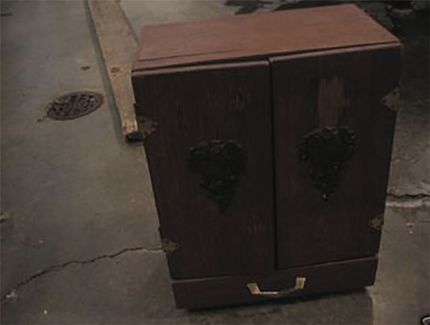We all grew up with tales of cursed objects and possessed dolls, but you probably don’t know that some of these disturbing stories have a basis in reality. Here the nine most cursed objects in the world that many believe have harmed, injured, or even killed.
The Cursed Amethyst

This gem was stolen from the Temple of Indra in Kanpur, India in the 19th century before bringing bad luck to its first owner, Colonel W. Ferris. After Ferris went bankrupt and lost everything, the gem was passed on to a troubled friend who soon thereafter committed suicide. The amethyst was then given to Edward Heron-Allen in 1890. Heron-Allen experienced bad luck of his own and watched friends who borrowed the jewel suffer. Fed up, he tossed the amethyst into Regent’s Canal hoping to be rid of the jewel once and for all—only to have a dealer find and return it months later. Finally accepting his fate, he stored it inside seven locked boxes in a bank vault until his death, at which point it was sent to the Natural History Museum in London where it still resides to this day.
Related: Return to Life: 5 Cases of Reincarnation that Will Give You Chills
The “Crying Boy” Painting

Spanish artist Bruno Amadio, also known as Giovani Bragolin, was a popular painter in the 1950s. He created a set of portraits featuring tearful, crying children. His work gained international attention after an article in The Sun in 1985 claimed that a print of one of his paintings, “Crying Boy,” was the cause for a string of house fires that had destroyed everything but left the prints untouched.
Hawaiian Lava Rocks

When traveling in Hawaii, you will likely hear of Pele’s curse, which states that anyone who takes something natively Hawaiian from the state will be cursed with bad luck. This belief extends from traditional lore about not spurning the volcano goddess and respecting her fiery divinity. However, it has taken on a unique power in recent years, despite the fact that taking rocks, sand, pumice, and other objects is already illegal. As a result of the curse, the Hawaiian National Parks Service has received hundreds of returned rocks with apology notes asking for forgiveness after assorted terrible events.
Thomas Busby’s Chair

Thomas Busby was a petty thief and alcoholic, hanged for murdering his father-in-law in 1702. When the law came for him, he was sitting in his favorite chair at the local inn. Before being hanged, he cursed anyone who sat in his chair to die violently. Years later, visitors of the inn would dare one another to sit in Busby’s chair. Some of these brave souls allegedly perished in strange accidents. The last apparent victim was a deliveryman who died in a car accident, hours after sitting in the cursed chair. Today, the chair hangs five feet off the ground for safety in the Thirsk Museum in North Yorkshire.
Related: Haunted Isle: 10 Spooky English Ghost Stories that will give you Goosebumps
Robert the Doll

At the start of the 20th century, a scorned servant gave a sailor doll to Robert Eugene (Gene) Otto, which he named after himself. Soon enough, the doll had his own seat at the dinner table and a place in the boy’s bed. Trouble began when Gene’s parents heard him and his doll talking, which was followed by Robert terrorizing the boy at night. Over time, it was left in the attic, though passing children claimed to see it move. After Gene’s death in 1974, a new family moved in with a young daughter who quickly grew to fear the doll. Robert was given to the Fort East Martello Museum & Gardens in Key West, Florida, where he resides to this day, safely locked within a glass case.
“The Hands Resist Him” Painting

In “The Hands Resist Him,” painted by Bill Stoneham, a California-based artist, a boy and doll-girl stand before a window covered in ghostly hands. The painting acquired its cursed reputation after the gallery owner who first displayed the artwork, the buyer, and the art critic who first wrote about the painting all died within years of one another. Quite the coincidence, right? That’s not the half of it. After the death of the original owner, the painting changed ownership to a family who claimed the figures in the painting actually moved at night, crawling out of the painting to cause mischief. It was eventually put on eBay, where gallery owner Kim Smith purchased the painting for $1,025. It now resides in the gallery’s storage space, hidden from view of unsuspecting art lovers.
Related: 5 of the World’s Most Cursed and Haunted Objects You Wouldn’t Want To Own
The Dybbuk Box

When author and antique dealer Kevin Mannis bought a wine cabinet at an estate sale, he did not expect to unleash an evil spirit. With the cabinet in the house, he and those around him began to experience nightmares of an old hag. Upon giving it to his mother, she suffered a stroke. From there, he turned to eBay, but each owner afterwards experienced terrible misfortunes. After much research, Mannis traced the cabinet back to a Polish Holocaust survivor named Havela, whose family believed it contained a dybbuk, a restless, malicious spirit of Jewish lore. The dybbuk box was eventually sold to J. Haxton of Missouri, who worked with local rabbis to seal the dybbuk in the box to prevent it from doing any further harm.
The Iceman

Although Otzi the Iceman died in 3300 BCE, his presence still haunts. As Europe’s oldest known natural mummy, he was found in 1991 in the Otztal Alps of Italy after having been preserved by the frigid mountain conditions. Initially, it was believed that he died of exposure, but later details showed that he died from blood loss from a fatal wound inflicted by an arrowhead. The legend of Otzi’s curse began as the people connected with his discovery began to die under mysterious circumstances. In all, the curse is said to have claimed seven lives, including a forensic pathologist who died in a car crash, a mountaineer who died in an avalanche, and the hiker who found him, who fell from a dangerous path. You can see Otzi, if you dare, at the South Tyrol Museum of Archaeology in Bolzano, South Tyrol, Italy.
James Dean’s Death Car

When James Dean died in 1955, the insurance company declared his Silver Porsche 550 Spyder a loss. The car was dismantled and its parts soon found their way into other vehicles. The drivetrain was sold to Dr. William F. Eschrich of Burbank (some publications spell his last name as Eschrid), a racer who was soon injured in a car crash. He was lucky, compared to another man who died while driving a car powered by Dean’s engine. Other incidents include a mechanic whose legs were crushed by the car and a truck driver killed in an accident while transporting its shell. After car designer George Barris bought and began touring the wreck, the Spyder caught fire while awaiting display as a safety exhibit, injuring none. The very next year, it disappeared while being transported across country.
Related: 8 True Crime Books About Mysterious High-Profile Celebrity Deaths
This Story Was First Published on Occult Museum.
Featured photo via Occult Museum; Additional photos: Sarah-Rose / Flickr (CC); Alchetron; Anders Sandberg / Flickr (CC); Unsolved Mysteries Wiki; eBay
